
A new film called Bughda, said to be the first in Adeni dialect, has recently been released. This is produced by the Adeni filmmakers at Jadaria. The trailer is on Youtube.
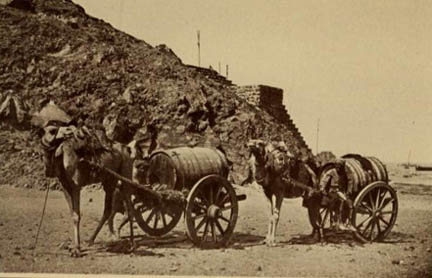
“Water carts used at Aden to bring water from the wells to the city.”
In a previous post I published a chapter from the 1911 book Zigzag Journeys in the Camel Country by Samuel and Amy Zwemer. The book has several photographs of Aden and the surrounding area, which are well worth a look a century later.
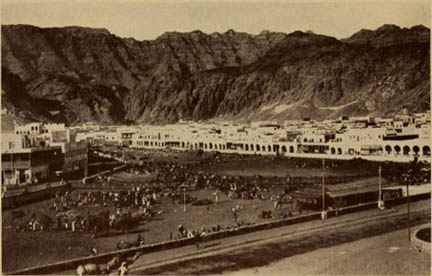
“The Big Camel market in the crater at Aden where we preached our first sermon in 1891.”
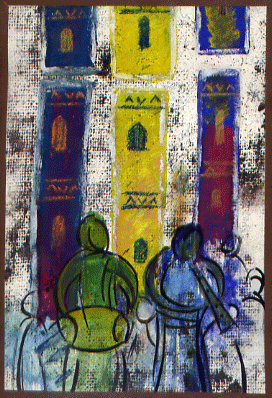
One of my most admired paintings by a Yemeni artist is the painting shown above by the Adeni artist Abdulla al-Ameen. I purchased the painting a decade ago at an exhibition sponsored by Yemen’s Ministry of Culture. Al-Ameen received an M.F.A. in 1984 from the Fine Arts Academy in Moscow. In addition to illustrations in books, he has designed stamps for the Yemeni government. In 1987 he received Kuwait’s “Golden Dhow Medal” for his artistic achievements.
I thank a friend for sending along these historic images of the Crescent hotel in Aden, taken while the Yemeni port was under British colonial control.
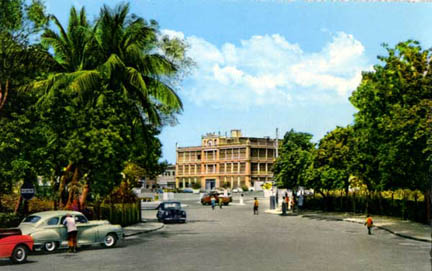
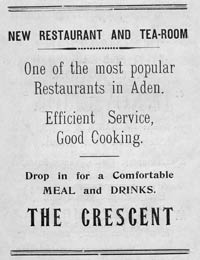
I thank a friend for sending along these images of Aden, taken in 1939 while the Yemeni port was under British colonial control.
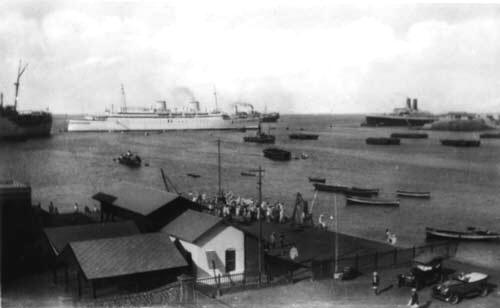
Steamer Point harbour & landing stage
I thank a friend for sending along these images of Aden, taken in 1906 while the Yemeni port was under British colonial control.
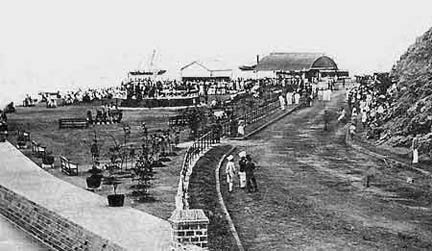
Jopp Gardens and Jopp Promenade
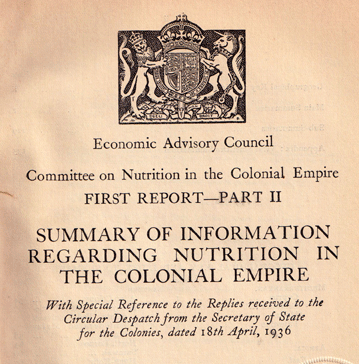
Say what you will about colonial empires, but at least they generate reports. I recently came across a British report to Parliament in 1939 entitled “Summary of Information Regarding Nutrition in the Colonial Empire.†Four pages are devoted to Aden Colony, which is said to have an area of 75 square miles, a population in 1931 of 45,992, a birthrate in 1937 of 32.07 per 1,000, an infant mortality rate in 1937 of 196.61 per 1,000, and a death rate in 1937 of 31.72 per 1,000. For part 1, click here. I attach more excerpts below:
3. Diet and Health (deficiency diseases and other relevant considerations). – On the whole, Aden can boast a high standard of public health. The greatest drawback is overcrowding. Large families occupy inadequate and ill-ventilated accommodations in which, as often as not, the domestic goat also claims a quota of space. In consequence of these conditions, respiratory and alimentary diseases are all too common. Diseases directly attributable to qualitative dietary deficiency are not a prominent feature of hospital returns in Aden and the more classical of the tropical diseases – beriberi, scurvy and pellagra – do not occur. Evidence of qualitative deficiency is found, however, in the incidence of rickets among children and of certain eye infections. An examination of 527 unselected children (consecutive cases treated in the Civil Hospital) showed that 33, 0r 6.2 per cent, were suffering from rickets. Continue reading Nutrition in Colonial Aden, #2

Say what you will about colonial empires, but at least they generate reports. I recently came across a British report to Parliament in 1939 entitled “Summary of Information Regarding Nutrition in the Colonial Empire.” Four pages are devoted to Aden Colony, which is said to have an area of 75 square miles, a population in 1931 of 45,992, a birthrate in 1937 of 32.07 per 1,000, an infant mortality rate in 1937 of 196.61 per 1,000, and a death rate in 1937 of 31.72 per 1,000. I attach excerpts below:
“1. General. – …This survey deals primarily with the 75 square miles of volcanic rock and sand which constitute the Colony of Aden; a detailed review of the nutritional affairs of the Protectorate has been postponed until a later date. The Colony is almost entirely urban and so cosmopolitan in make-up as to complicate the task of reviewing the nutritional conditions as a whole. Arabs, Jews, Somalis and Indians of various races predominate, and a preponderance of males is occasioned by the fact that those who come to Aden for varying periods of time to seek livelihood as coolies or tradesmen leave their womenfolk behind in the interior or in India. The natural division is to classify Arabs, Jews and the poorer classes of Indian Mohammedans as the indigenous population and it is to these, particularly the middle and lower classes, that the present nutritional considerations apply.
2. Composition and Nutritive Value of Dietary. – All the chief articles of diet are, with the exception of fish, imported from overseas or from Arabia. They are: rice, flour, sugar,; fish, mutton, beef, goat’s milk, eggs, ghee; fruits, vegetables, dates, lentils, simsim oil, tea, coffee and spices. Continue reading Nutrition in Colonial Aden, #1